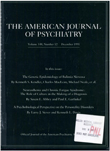Growth rate in adolescents with obsessive-compulsive disorder
Abstract
In an epidemiological study of 5,596 high school students, the authors identified 20 adolescents with obsessive-compulsive disorder and compared their physical size to that of adolescents of the same sex with no obsessive-compulsive symptoms. The obsessive-compulsive boys (N = 11) were shorter and weighed less than the other boys (N = 2,479) and were shorter than a subsample of normal boys (N = 33) and boys with other psychiatric diagnoses (N = 16). Regression analysis showed a flatter growth pattern through adolescence for the obsessive-compulsive boys (although within the 95% confidence limits for the other boys), suggesting a subtle neuroendocrine dysfunction in obsessive-compulsive disorder.
Access content
To read the fulltext, please use one of the options below to sign in or purchase access.- Personal login
- Institutional Login
- Sign in via OpenAthens
- Register for access
-
Please login/register if you wish to pair your device and check access availability.
Not a subscriber?
PsychiatryOnline subscription options offer access to the DSM-5 library, books, journals, CME, and patient resources. This all-in-one virtual library provides psychiatrists and mental health professionals with key resources for diagnosis, treatment, research, and professional development.
Need more help? PsychiatryOnline Customer Service may be reached by emailing [email protected] or by calling 800-368-5777 (in the U.S.) or 703-907-7322 (outside the U.S.).



